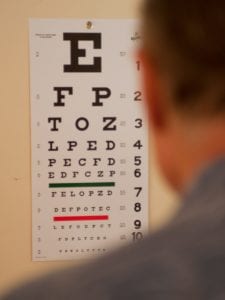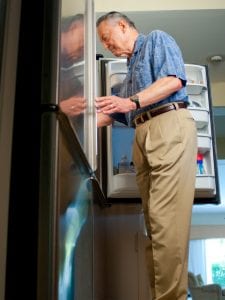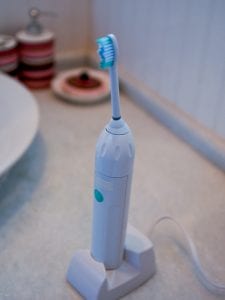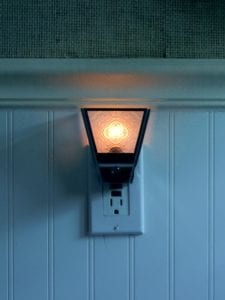Welcome to the educational program Environment Issues: Designing Safe Environments. This program will present some principles and strategies for improving home safety and for designing safe environments.
. . .
This is Lesson 20 of The Alzheimer’s Caregiver. You may view the topics in order as presented, or click on any topic listed in the main menu to be taken to that section.
We hope that you enjoy this program and find it useful in helping both yourself and those you care for. There are no easy answers when it comes to the care of another, as every situation and person is different. In addition, every caregiver comes with different experiences, skills, and attitudes about caregiving. Our hope is to offer you useful information and guidelines for caring for someone with dementia, but these guidelines will need to be adjusted to suit your own individual needs. Remember that your life experiences, your compassion and your inventiveness will go a long way toward enabling you to provide quality care.
Let’s get started.
Prefer to listen to this lesson? Click the Play button on the playlist below to begin.
Aging Changes and Dementia Factors
 Alzheimer’s disease typically affects people in their older years when they are also experiencing changes associated with aging. Both the changes due to aging and dementia should be taken into consideration when adapting the physical and human environments.
Alzheimer’s disease typically affects people in their older years when they are also experiencing changes associated with aging. Both the changes due to aging and dementia should be taken into consideration when adapting the physical and human environments.
Aging factors include a decrease in mobility due to the loss of muscle mass and joint flexibility as well as changes in bones. Falls and injuries become greater risks due to reduced mobility and balancing ability. Also associated with aging is vision loss caused by thickening and yellowing of the eye’s lens, decreased pupil size, slower reaction time to changes in light, and worsening depth perception and spatial orientation. Another aging factor is hearing loss, which can result in misunderstandings, confusion, and frustration.
Two common factors of dementia that may inhibit individuals from safely moving about their environment include agnosia and amnesia. Agnosia, is when a person’s ability to recognize things declines. Amnesia is the decline in memory.
Because of these factors, a person with Alzheimer’s disease can easily become lost in new surroundings and even in what should be familiar surroundings. In addition, a memory loss can cause people to forget the places they have just been or where they recently placed their belongings.
Case Study 1
Let’s begin with an example about Mary and her husband, Robert, who has Alzheimer’s disease.
Mary finds Robert on the floor by the front door. Robert is agitated and yelling.
- A. He fell down and is in pain.
- B. He forgot the way back to his room.
- C. He wanted to go outside and became frustrated when he could not unlock the door.
- D. All of the above.
Case Study 1 Answers:
Choice A: “He fell down and is in pain” is a possibility.There are many things that could have caused his fall, including furniture, dim lighting, or glare from the hard floor. Robert may have also become fatigued and fallen.
To help prevent falls, make sure there are plenty of chairs, couches, or benches for sitting and resting if the person becomes tired. Make sure that furniture is properly arranged to keep walkways unobstructed. And provide good lighting without glare.
Choice B: “He forgot the way back to his room” is another good choice.
People with dementia may not recognize environmental cues and often have difficulty finding their room, bathroom, or furniture. This can make them feel frightened, angry, or confused. One way to address this is to place signs that indicate direction, especially for important places like the bathroom. Also make sure that furniture remains in the same positions.
Choice C: “He wanted to go outside and became frustrated when he could not unlock the door” is another possibility.
Visible doors can tempt people with dementia to open them and go outside.
All exterior doors should be under close surveillance and locked when the person should not be going outside.
Choice D: For this case study question, choice D, “all of the above,” is the best answer.
All of these factors associated with aging and dementia should be taken into consideration when designing a safe environment.
Improving Home Safety
People with Alzheimer’s move through the disease in their own unique manner, though all become increasingly unable to take care of themselves. As a caregiver, you are faced with the ongoing challenge of adapting to each change in the person’s behavior and functioning. Because it is more effective to design a safe environment than it is to try and change most behaviors, it is important to learn some ideas about designing both the physical and emotional environments of those you care for. By using some simple strategies, you can learn to decrease the hazards and stressors that accompany these behavioral and functional changes. Because it is very difficult to predict what a person with dementia might do, caregivers must consider all possible behaviors, even if they have not yet occurred.
 Keep in mind that all individuals and their particular illness are unique and will respond in their own way and progress at their own pace. Today’s modifications may work now, but may not work as the illness progresses. On the other hand, a modification that didn’t work today may be “just the ticket” tomorrow. Observe carefully, keep your mind open and allow yourself to be creative in ways to adapt your home and your activities to the need that presents itself.
Keep in mind that all individuals and their particular illness are unique and will respond in their own way and progress at their own pace. Today’s modifications may work now, but may not work as the illness progresses. On the other hand, a modification that didn’t work today may be “just the ticket” tomorrow. Observe carefully, keep your mind open and allow yourself to be creative in ways to adapt your home and your activities to the need that presents itself.
Checking the safety of your home or facility, room by room, on an on-going basis will help reduce potentially hazardous situations. Though some dementia behaviors can be managed with medications, many cannot, so it is important to design a safe environment and to remember that even with the best-laid plans, accidents can happen.
General Safety Strategies
The following are some general strategies that can be used to help improve home safety.
Every home should have working smoke alarms installed in all of the rooms. Carbon monoxide detectors should also be installed. Cover all unused electrical outlets with safety covers. Remove all hazardous materials such as medications, chemicals, weapons, alcohol, lighters, plastic bags and power tools from sight and lock them away or use child safety latches on the cabinet doors. In  addition, all poisonous plants should be completely removed from the home and outside as well. Access to certain areas such as stairwells, decks, hot tubs and swimming pools must be prevented. Many child safety devices can be used to effectively restrict adults. Some other safety tips include reducing the sound competition in a room by turning off fans, or closing windows so that outside noises cannot be heard. Distractions and background noise can inhibit an elder’s ability to hear. Some modern needs for safety include posting no soliciting signs on front doors to reduce unannounced visitors. You may also want to use an answering machine for when you cannot answer phone calls. You should set the machine to the fewest number of rings possible so that the person with dementia is not tempted to answer the phone. Ringers should also be turned on low to avoid distraction and confusion. Try to keep telephones, cell phones, and computers safety out of the way to prevent misuse, damage, or misplacement. If valuable documents or materials are stored on a home computer, protect the files with passwords and frequently backup the files. Password protection for access to the Internet should also be set up. It is wise to consider monitoring the person’s computer use and installing software that screens for objectionable or offensive material on the Internet.
addition, all poisonous plants should be completely removed from the home and outside as well. Access to certain areas such as stairwells, decks, hot tubs and swimming pools must be prevented. Many child safety devices can be used to effectively restrict adults. Some other safety tips include reducing the sound competition in a room by turning off fans, or closing windows so that outside noises cannot be heard. Distractions and background noise can inhibit an elder’s ability to hear. Some modern needs for safety include posting no soliciting signs on front doors to reduce unannounced visitors. You may also want to use an answering machine for when you cannot answer phone calls. You should set the machine to the fewest number of rings possible so that the person with dementia is not tempted to answer the phone. Ringers should also be turned on low to avoid distraction and confusion. Try to keep telephones, cell phones, and computers safety out of the way to prevent misuse, damage, or misplacement. If valuable documents or materials are stored on a home computer, protect the files with passwords and frequently backup the files. Password protection for access to the Internet should also be set up. It is wise to consider monitoring the person’s computer use and installing software that screens for objectionable or offensive material on the Internet.
Doors and Windows
 Secure all windows and doors that the person should not be using. Exterior doors should have locks that require keys on both the inside and outside, and the keys should be kept away from the person. Locks can also be placed on interior doors. During the middle and late stages of Alzheimer’s, when wandering is more likely, doors can be disguised by covering them with a sheet or picture. Another option would be to place childproof covers on the doorknobs. Another simple approach is to try placing signs on doors that say things like, “Stop, “Do not open,” or “Keep out,” much like street signs. Another option is to install an alarm system that notifies people when doors are opened.
Secure all windows and doors that the person should not be using. Exterior doors should have locks that require keys on both the inside and outside, and the keys should be kept away from the person. Locks can also be placed on interior doors. During the middle and late stages of Alzheimer’s, when wandering is more likely, doors can be disguised by covering them with a sheet or picture. Another option would be to place childproof covers on the doorknobs. Another simple approach is to try placing signs on doors that say things like, “Stop, “Do not open,” or “Keep out,” much like street signs. Another option is to install an alarm system that notifies people when doors are opened.
Keep in mind that the inability to open a door can cause agitation. If living at home, remember to hide spare keys somewhere outside in case the person shuts the door and locks you out.
Bathroom doors should have the locks disabled or removed just in case the person locks the door while inside alone and is unable to open it.
Windows should also be locked, particularly in later stages of the illness. Windows should have drapes or shutters so they can be covered at night. Glass windows can function as a mirror at night and people in mid to late stage dementia can see their image and be frightened.
Preventing Falls and Burns
The following are some ideas to help prevent falls. First, include the installation of sturdy handrails at a comfortable height. This is especially important in transition areas such as stairways, which should have at least one handrail that extends beyond the first and last steps. If possible, stairways should be carpeted or have safety grip strips. Second, you should also avoid the use of extension cords by placing lamps and appliances close to electrical outlets. If extension cords must be used,  tack them to the baseboards to avoid tripping. Third, furniture, such as chairs, couches, or benches, need to be placed frequently and close together throughout the home or facility so that people can sit down whenever they feel tired. When introducing new objects into the environment, familiarize people to them to increase their chance of recognizing them in the future. Objects such as furniture should not block or project into pathways and should not be moved. Another way to prevent falls is to use sufficient lighting with little glare and to make sure that light switches are placed at the bottom and at the top of stairways.
tack them to the baseboards to avoid tripping. Third, furniture, such as chairs, couches, or benches, need to be placed frequently and close together throughout the home or facility so that people can sit down whenever they feel tired. When introducing new objects into the environment, familiarize people to them to increase their chance of recognizing them in the future. Objects such as furniture should not block or project into pathways and should not be moved. Another way to prevent falls is to use sufficient lighting with little glare and to make sure that light switches are placed at the bottom and at the top of stairways.
To help prevent burns from hot water, adjust the water heater to 120 degrees or place anti-scald devices on faucets. Make sure the hot and cold water are clearly labeled. If possible, it is safer to install single-handle faucets in the kitchen and bathroom. Avoid the use of flammable and volatile compounds near gas water heaters and place red tape around floor vents, radiators, and other heating devices to deter the person from standing on or touching a hot grid. If smoking is permitted, monitor the person when smoking. Remove matches, lighters, ashtrays, cigarettes, and other means of smoking from view. This reduces potential fire hazards, and with these reminders out of sight, the person may forget the desire to smoke. In bedrooms, be cautious when using electric mattress pads, electric blankets, electric sheets, or heating pads, as all of these things can cause burns.
Case Study 2
Let’s look at another situation with Mary and Robert.
Robert has just finished helping Mary bake some bread when Mary suggests taking a shower before dinner.
- A. He doesn’t want to leave the kitchen.
- B. He has a fear of bathing.
- C. He is afraid of slipping on the bathroom floor.
- D. He doesn’t remember how to get to the bathroom.
- E. All of above.
Case Study 2 Answers:
Choice A: “He doesn’t want to leave the kitchen” is a good possibility.
A kitchen can give a more home-like feeling than other environments. People often feel comforted recalling past memories in the kitchen.
Choice B: “He has a fear of bathing” is also a good possibility.
Bathing can become an uncomfortable activity for some people with dementia. There are many potential threats associated with bathing. People may fear being naked and vulnerable in front of others, even a spouse. They may become afraid of the water or the bathroom environment, which can sometimes feel cold and uninviting. Glare from the tile, porcelain, or metal in the bathroom can also cause glare, which can cause discomfort.
Choice C: “He is afraid of slipping on the bathroom floor” is another possibility.
Bathroom floors can be wet and slippery. If he has experienced a fall on the bathroom floor before, he may be afraid to go into a bathroom.
Choice D: “He doesn’t remember how to get to the bathroom” may also be a possibility.
Remember that because of agnosia and amnesia, a person with Alzheimer’s disease can forget where things are, even in an environment that should be familiar.
Choice E: Because all of these choices are good possibilities, choice E, “all of the above,” is the best answer.
Environments That Promote Way-Finding
The use of color is the primary finding and cueing device. Different colors can be used to contrast the floors, walls, and furniture, and can also be used to differentiate rooms. Using subtle or pastel colors are not advised, as they cannot be as easily discerned as brighter colors. You can also use different types of lighting to separate rooms. For example, use bright illumination in areas such as the bathroom and kitchen, and use softer lighting with bright task lighting in bedrooms and living rooms.
 The use of familiar objects such as paintings or tapestries can also help identify rooms. You can also use signs and photos on doors and walls to distinguish different rooms. For example, a familiar photo on the person’s room door can help distinguish that room. Keep in mind that a person’s ability to read deteriorates in the later stages of dementia. Lastly, the use of aromas can help to cue a person to what room they are in. Smells can be used throughout the home or facility and not just in the kitchen.
The use of familiar objects such as paintings or tapestries can also help identify rooms. You can also use signs and photos on doors and walls to distinguish different rooms. For example, a familiar photo on the person’s room door can help distinguish that room. Keep in mind that a person’s ability to read deteriorates in the later stages of dementia. Lastly, the use of aromas can help to cue a person to what room they are in. Smells can be used throughout the home or facility and not just in the kitchen.
Furniture is often used as landmarks, so items should be placed close together, though furniture should never block pathways, as people can trip over them. Because furniture can act as landmarks, pieces should remain in the same spot to avoid confusing people.
Different floor surfaces can be used to differentiate rooms, such as different colored carpets or tiles. But surfaces should be plain, without too many colors or patterns that can cause confusion.
Remember that no matter how well a room is designed, chances are you will have to repeatedly provide information when needed. Although it might be your tenth time explaining the same thing, for the person it seems like the first time hearing it, so try to be as patient as possible.
Designing Safe and Comfortable Kitchens (Part 1)
Kitchens are important places because they can trigger fond memories, help people to maintain certain skills, provide familiarity and comfort, and promote social interaction. Helping in kitchens can help people with dementia remember old competencies and feel like they are being productive. Cooking activities such as stirring, kneading and rolling dough, cookie cutting, icing baked goods, peeling with a “peeler,” washing vegetables, and cracking nuts can be encouraged based on the person’s abilities.
To facilitate such familiar activities, kitchens should provide both familiar and domestic features  such as cookware, kitchen tools, and favorite cookbooks. Word or pictorial labels for cupboards and drawers will enhance recognition. Kitchens should be organized and comfortable with sufficient workspace. The lighting must be bright and without glare or shadows. Removing unnecessary clutter will increase the workspace and decrease the risk of accidents. Floors should be kept clear, clean and dry so that they are not slippery. Putting up washable wallpaper can produce a home-like environment and make the walls easy to clean. An easy path to seating or other safe areas and sturdy furniture to help steady the gait when walking, can prevent falls and promote mobility. Comfortable chairs, simple but attractive décor, non-poisonous flowers and house plants can promote a sense of comfort and security.
such as cookware, kitchen tools, and favorite cookbooks. Word or pictorial labels for cupboards and drawers will enhance recognition. Kitchens should be organized and comfortable with sufficient workspace. The lighting must be bright and without glare or shadows. Removing unnecessary clutter will increase the workspace and decrease the risk of accidents. Floors should be kept clear, clean and dry so that they are not slippery. Putting up washable wallpaper can produce a home-like environment and make the walls easy to clean. An easy path to seating or other safe areas and sturdy furniture to help steady the gait when walking, can prevent falls and promote mobility. Comfortable chairs, simple but attractive décor, non-poisonous flowers and house plants can promote a sense of comfort and security.
Designing Safe and Comfortable Kitchens (Part 2)
Since kitchens are often a place with lots of dangerous items such as knives and chemicals, it is very important to take  precautions. Store dangerous items behind locked or safety-latched doors. Early on, it may be useful for your person to have access to cupboards for cups or snacks, for example. At some point, you may need either to remove potentially hazardous content or latch or lock cupboards and drawers.
precautions. Store dangerous items behind locked or safety-latched doors. Early on, it may be useful for your person to have access to cupboards for cups or snacks, for example. At some point, you may need either to remove potentially hazardous content or latch or lock cupboards and drawers.
Electrical appliances, such as toasters and hotpots, come with an automatic shut-off switch, which may be safe during the earlier stages of Alzheimer’s. But other appliances, such as food processors, electric mixers, coffee grinders, and toaster ovens are best left stored in locked closets even in the early stages.
Another dangerous item in the kitchen is the stove. As the illness progresses, remove the knobs from the oven and cook-top and install a master cut-off switch for all electrical appliances as well as the cook-top and oven. Covering the burners may also decrease the risk of burns or fires. Using automatic shut-off timers on ovens and toasters is also a good idea. Stoves can be equipped with locks if necessary. Everything within the kitchen should be fire-resistant.
Also, consider locking refrigerators, as people with dementia tend to take excessive amounts of food. Always dispose of spoiled food, as those with dementia may try to eat it.
Garbage disposals should be dismantled, as people with dementia may place objects or their own hands in the disposal. Instead, insert a drain trap in the kitchen sink to catch anything that may otherwise become lost or clog the plumbing. To decrease the risk of choking, remove any artificial fruits and vegetables or food-shaped kitchen magnets, which might appear edible to someone with dementia.
Designing Safe and Comfortable Kitchens (Part 3)
 Water temperature from the kitchen faucet should be kept below 105 to 108 degrees F. Sharp knives may be okay during the early stage of Alzheimer’s, but should not be used as the disease progresses and perception and judgment decline. So these should be stored in a drawer that is either locked or out of reach.
Water temperature from the kitchen faucet should be kept below 105 to 108 degrees F. Sharp knives may be okay during the early stage of Alzheimer’s, but should not be used as the disease progresses and perception and judgment decline. So these should be stored in a drawer that is either locked or out of reach.
Cleaning fluids, bleach, hydrogen peroxide, rubbing alcohol, and other hazardous liquids should be locked away. A person with more advanced dementia may have difficulty distinguishing a container of orange juice from an orange colored container of cleaning fluid.
Wandering in the Kitchen
 Many people in the early and mid-stages of Alzheimer’s will wake in the middle of the night and wander around the house, often heading to the kitchen. Night lights, leaving a cup out for a drink of water, making sure the power is off for appliances, and storing away all hazardous objects and substances, are important preventive measures.
Many people in the early and mid-stages of Alzheimer’s will wake in the middle of the night and wander around the house, often heading to the kitchen. Night lights, leaving a cup out for a drink of water, making sure the power is off for appliances, and storing away all hazardous objects and substances, are important preventive measures.
Consider installing drain traps in the kitchen sink in case a valuable item falls into it.
Also, most homes have a “junk drawer” where odd items are kept, including matches, small tools, pet medicines, plastic bags, and other potentially hazardous miscellaneous items. These items are best discarded or stored in a locked or inaccessible place.
Medications in the Kitchen
 Many people keep their prescription drugs in the kitchen for convenience. Even in the early stages of Alzheimer’s disease, it is best to keep these medications locked away. Many older individuals are taking multiple drugs for multiple conditions, and the administration of these are complex. Some must be taken with meals, some must be taken at specific times of the day. Because of the complexity of medication regimens, medication usage is hazardous even for people without dementia. Many pills look alike. And some people incorrectly believe that if one pill works, two may work better, without considering the dangerous side effects. Of course, medications are essential in the treatment of any condition, and those prescribed for Alzheimer’s disease are very important. Caregivers should prepare medications in advance in a “pill caddy” that is kept safely away from the care recipient. They should oversee or be responsible for the dispensing of pills from the pill caddy and control all medications in the house.
Many people keep their prescription drugs in the kitchen for convenience. Even in the early stages of Alzheimer’s disease, it is best to keep these medications locked away. Many older individuals are taking multiple drugs for multiple conditions, and the administration of these are complex. Some must be taken with meals, some must be taken at specific times of the day. Because of the complexity of medication regimens, medication usage is hazardous even for people without dementia. Many pills look alike. And some people incorrectly believe that if one pill works, two may work better, without considering the dangerous side effects. Of course, medications are essential in the treatment of any condition, and those prescribed for Alzheimer’s disease are very important. Caregivers should prepare medications in advance in a “pill caddy” that is kept safely away from the care recipient. They should oversee or be responsible for the dispensing of pills from the pill caddy and control all medications in the house.
Designing Safe Bathrooms
Because people with Alzheimer’s are likely to have impaired mobility and cognition, bathing can become a very challenging activity. It may help if those with dementia have their own personal bathroom, as having a private space can help to bring comfort during bathing and toileting.
If possible, bathrooms should be located adjacent to bedrooms or shared living spaces and be visible. Putting a sign on the door, or painting the bathroom door with a bright color can help people identify the bathroom. It is also important to leave the bathroom door open when it is vacant.
Because those with dementia loose the ability to distinguish noise and sounds, moisture-resistant acoustic ceiling materials can help with hearing. In addition, people must remove their glasses while bathing, so it is essential to provide good lighting. The use of indirect lighting can help reduce glare, though bathing in daylight is better than artificial lighting.
 Locks on bathroom doors should be removed to prevent the person with Alzheimer’s from getting locked inside, or locking you out. Bathtubs should be easily accessible on at least two sides to make it easier for the caregiver to assist with bathing or showering. Nonskid adhesive strips, decals, or mats should be placed in the tub or shower. If the bathroom is uncarpeted, consider placing nonskid strips or bath mats next to the tub, toilet and sink. Try to keep the floors dry at all times. Because bathroom floors can be become slippery from water, consider installing washable, wall-to-wall carpeting to prevent slipping on wet tile floors. Rugs should be used with caution because they can cause tripping and falls. All of the walls and doors in the bathroom should be water-resistant. Color contrasts should be used between the floor and walls, floor and countertop, and sink and countertop.
Locks on bathroom doors should be removed to prevent the person with Alzheimer’s from getting locked inside, or locking you out. Bathtubs should be easily accessible on at least two sides to make it easier for the caregiver to assist with bathing or showering. Nonskid adhesive strips, decals, or mats should be placed in the tub or shower. If the bathroom is uncarpeted, consider placing nonskid strips or bath mats next to the tub, toilet and sink. Try to keep the floors dry at all times. Because bathroom floors can be become slippery from water, consider installing washable, wall-to-wall carpeting to prevent slipping on wet tile floors. Rugs should be used with caution because they can cause tripping and falls. All of the walls and doors in the bathroom should be water-resistant. Color contrasts should be used between the floor and walls, floor and countertop, and sink and countertop.
Grab bars should be placed in all essential transfer spots such as the bathtub and toilet areas. It is best to avoid bathtubs that are equipped with automatic lifting hoists, as they often frighten people with dementia. For bathing, handheld showers can be helpful and are best used when a caregiver is assisting.
A rubber faucet cover (often used for small children) should be placed on the bathtub faucet to prevent serious injury should the person with Alzheimer’s fall in the tub.
Electrical Appliances
Dedicate the bathroom for the bathing experience. As most are aware, water and electricity do not “mix well.” Electrical outlets can be covered with plastic inserts. Electrical grooming appliances such as hair curlers, dryers and electric shavers can be removed from the bathroom and used in a bedroom or other room without a water source. Battery powered shavers are an alternative that are safe to use in bathrooms.
 Electric toothbrushes are also an exception as a sink is desirable when brushing teeth. However, the electric toothbrush is actually battery powered. The electrical connection is simply to recharge the battery. So, the base of the electric toothbrush can be kept in another room to charge the toothbrush. After charging, the toothbrush can be taken to a sink for use.
Electric toothbrushes are also an exception as a sink is desirable when brushing teeth. However, the electric toothbrush is actually battery powered. The electrical connection is simply to recharge the battery. So, the base of the electric toothbrush can be kept in another room to charge the toothbrush. After charging, the toothbrush can be taken to a sink for use.
Free-standing, battery powered toothbrushes are also available. Battery powered toothbrushes do not require electrical recharging and so have low risk of electrical injuries.
Designing Safe Bedrooms

When designing a bedroom it is best to anticipate the reasons why a person with Alzheimer’s might get out of bed. Reasons may include things such as hunger, thirst, going to the bathroom, restlessness and pain. The following are some strategies to try and safely meet these needs before a problem arises. Try to have things that the person might need or want nearby or easily accessible. Use night-lights or dim but adequate lighting to help guide the person when going to the bathroom or just wandering at night. A good idea is to use an intercom device (often used for infants) in both the bedroom and bathroom to alert you to any noises indicating falls or a need for help. Remove any throw rugs, as they often cause slips and falls. Remove portable space heaters if they pose burn risks. If you use portable fans, be sure that objects cannot be placed in the blades. Other reasons for getting out of bed include the person accidentally falling out of bed. Some suggestions for helping this include placing mats next to the bed, as long as this does not create a greater risk of accidents. You may also want to consider using a hospital-type bed with rails. If this type of bed is chosen, here are a few tips. First, get a bed that can be raised and lowered to accommodate both the person with Alzheimer’s and the caregiver. Second, keep the bed in its lowest position with the wheels locked. Finally, always use a proper sized mattress or a mattress with raised foam edges to prevent the person from being trapped between the mattress and rail.
Garage and Basement
 The garage and basement should be kept off limits for people with dementia. In the garage, tools, fluids, sporting equipment, and access to the car can be unsafe. Men, particularly, can be very tempted to use the tools, tinker with the car engine, and even get in and drive. Doors to the garage, both from the inside and exterior, should be securely locked. Keys to the car should be locked away.
The garage and basement should be kept off limits for people with dementia. In the garage, tools, fluids, sporting equipment, and access to the car can be unsafe. Men, particularly, can be very tempted to use the tools, tinker with the car engine, and even get in and drive. Doors to the garage, both from the inside and exterior, should be securely locked. Keys to the car should be locked away. If there is a basement, it is often filled with some of the same types of items found in a garage. However, there may be additional equipment, such as a washer and drier, water softener, circuit breaker, and furnace. Tampering with any of these items could be hazardous, and so, as with the garage, the area should be “off limits”.
Yard and Garden
 Outside activities can reduce feelings of confinement and provide a sense of general well-being. Moreover, outside activities have many health benefits associated with exposure to sunlight. Quality time spent outside can improve overall physical conditioning, appetite, sleep patterns, awareness, orientation, and confidence. Feelings of loneliness tend to decrease, along with agitation and anxiety.
Outside activities can reduce feelings of confinement and provide a sense of general well-being. Moreover, outside activities have many health benefits associated with exposure to sunlight. Quality time spent outside can improve overall physical conditioning, appetite, sleep patterns, awareness, orientation, and confidence. Feelings of loneliness tend to decrease, along with agitation and anxiety.
Working in the yard and garden can be a pleasant and productive activity for someone in the early and middle stages of Alzheimer’s. Pulling weeds, sweeping the walkway, and checking the mailbox can provide the individual with useful activities that support independence and a sense of self-worth. If a person is inclined to wander, and the yard is not enclosed, this could pose a potential danger. In that case, a caregiver should stay outside with the person.
Designing Safe Outside Environments
Several steps can be taken to make the outdoors safer for people with dementia.
 An enclosed back yard and can provide a space for wandering and exploring for an individual with dementia. A path can be laid out with safe plants, shade, and a bench for resting. The path should be level without obstacles, leading around the garden without dead ends and bring the person back to the back door or patio where they started. To reduce the risk of falls, install non-slip, glare-free walking paths and repair any uneven or damaged surfaces or walkways. In addition, hoses, or other objects that may cause a person to trip should be removed. Bushes and foliage should be pruned well away from walkways and doorways. All stairs and uneven edges should be clearly marked with bright or reflective tape or paint. When designing fencing and wall placement, it is important to prevent confined spaces. Use fences and walls that do not completely obscure a person’s view. Fences and trees should be far enough away from the residence to prevent climbing on them. Landmarks should also be placed to serve as cues for such things as entrances and exits.
An enclosed back yard and can provide a space for wandering and exploring for an individual with dementia. A path can be laid out with safe plants, shade, and a bench for resting. The path should be level without obstacles, leading around the garden without dead ends and bring the person back to the back door or patio where they started. To reduce the risk of falls, install non-slip, glare-free walking paths and repair any uneven or damaged surfaces or walkways. In addition, hoses, or other objects that may cause a person to trip should be removed. Bushes and foliage should be pruned well away from walkways and doorways. All stairs and uneven edges should be clearly marked with bright or reflective tape or paint. When designing fencing and wall placement, it is important to prevent confined spaces. Use fences and walls that do not completely obscure a person’s view. Fences and trees should be far enough away from the residence to prevent climbing on them. Landmarks should also be placed to serve as cues for such things as entrances and exits.
A vegetable or flower garden can provide a stimulating activity for the individual and awaken memories of earlier times. Make sure that all accessible plants and materials are nontoxic. You can call your local poison center to determine what is and what is not poisonous.
Because people with dementia are more sensitive to harsh weather conditions, the creation of a comfortable microclimate is helpful. Features, such as strategically placed plantings and trees, can be designed to serve as wind breaks and provide shade. Enclosures can allow people to use the outdoor environment throughout the year. A greenhouse or chosen natural area inside are also ways to enjoy nature. You can also build raised planting beds inside or outside for the disabled person who enjoys gardening.
Summary
In summary, dementia caregivers are faced with the ongoing challenge of adapting to changes in the person’s behavior and functioning. It is more effective to design a safe environment than it is to try and change many potentially dangerous behaviors.
The design process should start with some of the basic safety necessities that all homes should have. This includes securing the doors and windows and covering unused electrical outlets. Every home should have working smoke and carbon monoxide detectors. All hazardous materials such as medications, chemicals, weapons, alcohol, lighters, plastic bags and power tools should be removed from sight and locked away. Finally, access to certain areas such as stairwells, decks, hot tubs and swimming pools must be prevented.
Environments should also be designed to reduce the risk of falls and accidental burns. Preventing falls is best done by keeping areas well lit and free of clutter. Accidental burns can best be prevented by making sure that the person stays away from things that can burn them.
Kitchens and bathrooms can be very hazardous areas of the home. In the kitchen, precautions such as removing knobs and installing master cut-off switches for electrical appliances and cook tops are useful precautions. In the bathroom, precautions should be taken regarding water temperature, non-slip floors, electrical outlets and equipment. The garage and basement are spaces that should be “off limits” whereas, the yard and garden should be places of enjoyment for those with dementia.
← Previous Lesson (Early Stages: Intimacy and Sexuality)
→ Next Lesson (Environment Issues: The Human Environment)
. . .
Written by: Catherine M. Harris, PhD, RNCS (University of New Mexico College of Nursing), and Juh Hyun Shin, PhD, RN (University of Iowa College of Nursing)
Edited by: Mindy J. Kim-Miller, MD, PhD (University of Chicago School of Medicine)
References:
- Bowlby, C. (1993). Therapeutic activities with persons disabled by Alzheimer’s disease and related disorders. Gaithersburg: Aspen Publishers. pp. 165
- Brawley, E. C. (1997). Designing for Alzheimer’s disease: Strategies for creating better care. John Wiley& Sons, Inc.: NY
- Brawley, E. C. (2004). Gardens of memories. Alzheimer’s Care Quarterly. 5(2). 154-164.
- BS-Engineering, J. N., Kujoth, J., & Torgrude, S. (2002). Using postoccupancy evaluation to guide bathroom design in a dementia-specific, assisted living facility. Alzheimer’s Care Quarterly, 3(1):32-37
- Calkins, M. P. (1989). Designing dues for wanderers; Special needs in nursing homes. Architecture. 78(10), 117-118.
- Calkins MP & Namazi KH. (1991). Caregivers perceptions of the effectiveness of home modifications for community living adults with dementia. Journal of Alzheimer’s Care and Related Disorder Research, 6(1):25-29.
- Cohen, Uriel & Weisman, Gerald D. (1991). Holding on to home: Designing environments for people with dementia. Baltimore. The Johns Hopkins University Press.
- Couzens, J. (1999). Giving new life through the Eden Alternative. Michigan Health Hospital, 35(2), 13.
- Delta Society. (2008). Pet Partners® program. Retrieved on March 31, 2009 from https://www.deltasociety.org/Page.aspx?pid=259.
- Gerdner, L., A. & Swanson, E., A. (1993). Effects of individualized music on confused and agitated elderly patients. Archives of Psychiatric Nursing.7(5), 284-291.
- Gitlin, L. N. & Corcoran, M. (2000). Making homes safer; Environmental adaptations for people with dementia. Alzheimer’s Care Quarterly, 1(1), 50-58.Grau, L., Teresi, J., & Chandler, B. (1993).
- Demoralization among sons, daughters, and other relatives of nursing home residents. Research on Aging, 13, 324-345.
- Hamilton, N., & Tesh, A. S. (2002). The North Carolina Eden Coalition: facilitating
- environmental transformation. Journal of Gerontolical Nursing, 28(3), 35-40.
- Harvath, T. A., Archbold, P. G., Stewart, B., Gadow, S., Kirschling, J. M., Miller, L., Hagan, J., Brody, K., & Schook, J. (1994). Establishing partnerships with family caregivers: Local and cosmopolitan knowledge. Journal of Gerontological Nursing, 20(2), 29-35.
- Hiatt, L. (1981). Designing therapeutic dinning. Nursing Homes, April/May, 33-39
- Kayser-Jones (1989). The environment and quality of care in long-term care: Research and practice (NLN Publication No. 202292), New York: NationalLeague for Nursing.
- Kayser-Jones, J. S. (1991). The impact of the environment on the quality of care in nursing homes: A social-psychological perspective. Holistic Nursing in Practice, 5(3), 29-38.
- Keen, J. (1989). Interiors: Architecture in the lives of people with dementia. International Journal of Geriatric Psychiatry, 4, 255-272.
- Kitwood, T., & Bredin, K. (1992). Toward a theory of dementia care: Personhood and well-being. Aging and Society, 12, 269-287.
- Laxton, C. (1985). The John D. French Center for Alzheimer’s disease. Caring. Dec. 22-24
- Lawton, M. P.(1981). Sensory deprivation and the effect pf the environment on management of the patient with senile dementia. In Miller N, E., Cohen,G. D.(Eds). Clinical Aspects of Alzheimer’s Disease, Aging Series. New York. Raven Press : 15: 227-249
- Liss, L. Letter to the Editor- benefit of access to outdoors. Ame J Alzheimer Dis Res CARE. 1(4): 5
- March, S. D. (2002). Creating an environment for community, 3(1):61-66
- Meyers A. (2004). Richmond VA Medical Center first to achieve Eden Alternative registration. Virginia Nurses Today. 12(2), 16.
- Morgan, D. G. & Stewart, N. J. (1997). The importance of the social environment in dementia care, Western Journal of Nursing Research, 19(6), 740-761.
- Nagy, J. W. (2002). Kitchens that help residents reestablish home. Alzhiemer’s Care Quarterly, 3(1) : 74-77
- National Institute on Aging. (February 5, 2009). Home Safety for People with Alzheimer’s Disease. Retrieved on March 30, 2009 from http://www.nia.nih.gov/Alzheimers/Publications/homesafety.htm.
- National Institute on Aging. (November 7, 2008). Falls and older adults: preventing falls and fractures – home safety. Retrieved on March 30, 2008 from http://nihseniorhealth.gov/falls/homesafety/02.html.
- Norberg, A., Melin, E., & Asplund, K. (1986). Reactions to music, touch, and object presentation in the final stage of dementia: An explanatory study.International Journal of Nursing Studies, 23(4), 315-323.
- Peak, T. (2000). Families and the nursing homes environment: Adaptation in a group context. Journal of Gerontological Social Work, 33(1), 51-66.
- Perris, S. M., Kinney, J. M., & Osgrocki, P. (1991). Stressors and well-being among caregivers to older adults with dementia: The in-home versus nursing home experienced. The Gerontologist. 31, 217-223.
- Ragneskog, H., Kihlgren, M., Karlsson, I., Norberg, A., Gerdner, L., & Buckwalter, K. (1996). Dinner music for demented patients: Analysis of videorecorded observations. Clinical Nursing Research, 5(3), 262-277.
- Rantz, M., Popejoy, L. & Zwygart-Stauffacher, M. (2001). The new nursing homes: A 20-Minute way to find great long-term care. Fairview Press:Minneapolis.
- Roach, M. (1984). Reflections in a fake mirror. Discover, 8, 76-85
- Ross, M., Rosenthal, C., & Dawson, P. (1998). Spousal caregiving in the institutional setting: Visiting. Journal of Clinical Nursing, 6, 473-484.
- Ross, M., Creswell, A., & Dalziel, W. (2001). Family caregiving in long-term care facilities. Clinical Nursing Research, 10(4), 347-363.
- Rowles, G. D. & High, D. M. (1996). Individualizing care: Family roles in nursing home decision-making. Journal of Gerontological Nursing, 22(3), 20-25.Saperstein, A. R., Calkins, M. P., Haitsma, K. V., & Curyto, K. (2004). Missed opportunities; The disconnect between physical design and programming and operations. Alzheimer’s Care Quarterly, 5(4), 324-331Stolley, J., M., Koenig, H., & Buckwalter, K.C. (1999). Pastoral care fort the person with dementia. Journal of Health Care Chaplaincy, 8(1/2), 7-23.
- Ruckdeschel, K., & Van Haitsma, K. (2001) The impacts of live-in animals and plants on nursing home residents: a pilot longitudinal investigation.Alzheimer’s Care Quarterly. 2(4),17-27
- Snyder, L. (1984). Archetypal place and the needs of the aging. In M. Spival (Ed). Institutional settings: An environmental design approach. New York :Human Science Press
- Snyder, L., Rupprecht, P., Pyrek, J., Brekhus, S., & Moss, T.,(1978) Wandering. Gerontologist, 18(3), 272-280
- Tesh, A. S., McNutt, K., Courts, N. F., & Barba, B. E. (2002). Characteristics of nursing homes adopting environmental transformations. Journal of Gerontological Nursing, 28(3), 28-34
- Thomas, W. (1998). Long-Term Care Design: Cultural expectations & locale creating the edergarden. Journal of Healthcare Design, 10, 63-66.
- Warner M & Warner E (1996). The caregiver’s guide to home modification. In M L Warner: The complete guide to Alzheimer’s proofing your home.Purdue University Press.
- Zeisel, J. (2000). Architecture and Design: Environmental design effects on Alzheimer symptoms in long term care residences. World Hospitals and Health Services, 36(3), 27-31.

